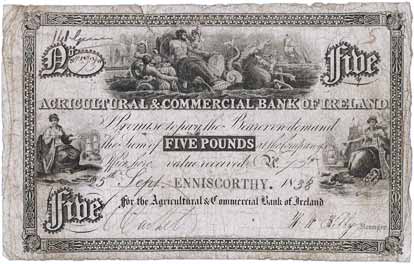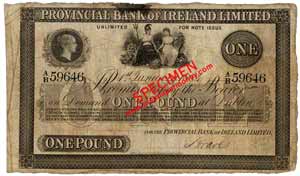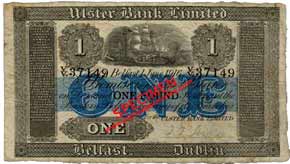Prior to 1824 only Private banks with six partners or less could issue paper money in Ireland, with the sole exception of the The Bank of Ireland which was established by Royal Charter on 10 May 1783, by a group of over 200 Irish businessmen, land owners and clergymen, to stimulate and regulate the Irish economy and to provide it with a stable banknote currency. Joint stock banks were prohibited by legislation.
The Bank of Ireland was somewhat like a modern central bank. However, the bank focused almost entirely on Dublin. The rest of the country had to rely on the private banks, which tended to be too weak in capital and scope to allow the economy to prosper to any degree.
The Irish Banking Acts, of 1821, 1824, and 1825 cleared the way for the formation of adequately capitalised Joint Stock banks in Ireland. All banks with headquarters outside of a 50 mile radius of Dublin had the right to issue banknotes under various rules and restrictions.


Within the Dublin zone the Bank of Ireland retained a monopoly on note issue. By 1840 there were six Joint Stock Banks of note issue. The Agricultural and Commercial Bank, and its two descendants, the Southern Bank of Ireland and the Provident Bank of Ireland, had failed a few years previously
The Bankers (Ireland) Act, 1845 made many reforms to the system. It precluded any newly formed banks from issuing banknotes. It also abolished the monopoly that the the Bank of Ireland had in the Dublin zone, and it prohibited the issue of fractional denominated notes—thus 30 Shilling note denominations, one of the most common in circulation, had to be withdrawn.
By the 1860s six of the larger Joint Stock banks had the right of note issue. They were: Bank of Ireland, National Bank, Ulster Bank, Northern Bank, Provincial Bank of Ireland, Belfast Banking Company.
The banks provided a reliable banking system and currency for the country. For the week ending, 18th June 1910, the average daily circulation of the notes issued by the six Irish Joint-Stock banks added up to £6,354,494. Slightly over half this total were notes of the Bank of Ireland.
None of the notes issued by the six banks were ever legal tender except during World War 1. British Treasury notes, introduced in 1914, circulated alongside the issues of the banks as well as English coinage. The Treasury notes were the only Legal Tender Paper currency in use.
The right of note issue continued during the early years of the Irish Free State. The Currency Act 1927 provided for the creation of the Currency Commission Ireland to control the issue of currency in the new Irish state.
In 1928 the Currency Commission commenced the issue of Series A Legal Tender Notes. In 1929 the Associated Banks' (commercial banks) issues in the island of Ireland split into Consolidated Banknotes controlled by the Currency Commission in the Irish Free State, and a new Belfast issue in Northern Ireland. The Consolidated Banknote Issue replaced the banks' own note issues in the Irish Free State.
There are four basic Type groups for the old banknotes issued by Joint Stock banks in the period 1783 - 1928. The designs of the notes themselves evolved significantly throughout the hundred or so years from 1820 to 1920.
Early Single Branch Issues 1783 - ca1868
Large Size Banknotes
Each banknote bore the name of its issuing branch, where it was payable, and that of the head office of the bank.
Multi-Branch Issues ca1852 - ca1920
Large Size Banknotes and Small Size Banknotes
All banks with the right of note issue listed all of their branches on each note as locations where their notes were payable.
Single Branch Issues ca1920 - 1921
Large Size and Small Size Banknotes
From 1920 the banks were no longer required to list all of their branches on each note. Most notes listed only the head office in Dublin or Belfast. Some banks listed both of these branches.
Pre-Currency Commission Irish Free State Issues 1922 - 1928
Small Size Banknotes
Most of the banks produced new modern small sized notes at this time which circulated both in the Irish Free State and in Northern Ireland.








Special Sections and Articles
Irish Joint Stock Banks of Note Issue from 1783
Contemporary Forgeries of Early Irish Banknotes ca1800-1930
Banknote Design Evolution 1824 to 1916
Irish Three Pound Notes of the Joint Stock Banks
The Transition of Irish Currency, Irish banknotes 1918–1928
The Partition of Irish currency, Irish banknotes 1928–1930